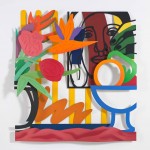When I think about Andy Warhol, I don’t just think about Liz Taylor. I often remember his series of car-crash and electric-chair screen-prints (plus those ones of the people jumping to their deaths off of skyscrapers) just as much as his over-the-top prints that both parody and enthrone superstars like Liz, Farrah Fawcett, Elvis, and so on. His version of Pop art was about a lot of things, but the engine inside the gloss was Warhol’s sense of death and violence, the unsettling unknown, that lion-mean whisper behind all of the glamor and the desire to be applauded and adored. The juxtaposition of misery and ecstasy, lipstick and broken windshield, made Warhol’s whole oeuvre transform outside of itself into kinky, creepy poetry, finally encapsulating an era dominated by advertising, movies, TV, and newspapers, all of these media letting us see ourselves both as the way we want to be and the way we end up.
I kept going back to why I love Warhol while wandering through “Beyond Pop Art: A Retrospective of Tom Wesselmann,” at the Cincinnati Museum of Art, up through January 18, 2015. It’s a vast exhibit, chockfull of a lot of marvelous paintings, drawings (many accomplished in steel), sculptures, collages, and so on. That vastness is very impressive, but it also allows you to take a look at a trajectory that doesn’t seem to be there. Wesselmann’s work doesn’t seem beyond Pop art exactly; in fact it seems kind of totally and a little too much in sync with it, stylishly old-fashioned and beholden to an aesthetic straight out of a previous era. Matisse is Wesselmann’s role model, not American billboards or tabloid photos, and definitely not ironic, zeitgeist drama.
Wesselmann’s reaction to Pop is to contain it in a very tidy realm of supreme competence. In his vibrant works, the subject matter is often either resplendent anonymous naked ladies or the consumer goods that make them that way, and through his slavish adherence to his own codes Wesselmann verifies beauty, doesn’t double-check it and never questions it. His muse is the same Matisse muse doing an old-school odalisque. Mainly he seems to want to “Matisse-ify” Pop’s icons and symbols. More interested in elevating than in investigating, he finds inspiration on a grand but somehow unchallenging scale, connecting to Pop’s desire for sumptuousness and size, finalizing all the subject matter (billboard mayonnaise jars, lipsticks, cigarettes, lips, etc.) into a mausoleum of aesthetic bliss, almost like nostalgia but without the wistfulness, the letdown of desire.
There’s no engine inside this gloss.
- Tom Wesselmann (American, b.1931, d.2004) Mixed Bouquet and Leger (3-D), 1992 oil on cut-out aluminum 75 x 70 x 9 in. Lent by Claire Wesselmann. © Estate of Tom Wesselmann/Licensed by VAGA, New York, NY, Photo Credit: Jeffrey Sturges
- Tom Wesselmann (American, b.1931, d.2004) Still Life #20, 1962 oil, collage, and assemblage onboard (mixed media) 47 3/4 x 48 x 10 1/2 in. Collection Albright-Knox Art Gallery Buffalo, New York. Gift of Seymour H. Knox, Jr., 1962. © Estate of Tom Wesselmann/Licensed by VAGA, New York, NY.
- Tom Wesselmann (American, b.1931, d.2004) Landscape #5, 1965 oil on canvas and Liquitex and collage on canvas 84 x 144 1/2 x 18 in. Lent by Claire Wesselmann. © Estate of Tom Wesselmann/Licensed by VAGA, New York, NY, Photo Credit: Jeffrey Sturges
The main attraction gets to my point pretty clearly. “Still Life No. 60,” from 1973 is a huge completely deadpan paean to old-school cinematic allure. Close to 30 feet long and 10 feet high, it’s an oil-painted display of a giant lady’s bedside table accoutrements. It’s fun and large and yet also has a Mardi Gras parade float finesse, an adherence to what it is, as opposed to trying to take on what it isn’t. There’s no disjuncture, just worship, and while I guess Pop art’s adoration of pop is one of its chief pleasures, even one of its manifestos, the main reason (at least for me) Pop art reverberates and has lasted and made such an impact is that it finds the joke within the adoration, grabs meaning from glorification. Think of James Rosenquist’s funky, orgiastic, poetic wall spectacles, or Roy Lichtenstein’s tongue-in-cheek selections of grainy cartoons blown up into ironic Greek tragedies, or Claes Oldenberg’s deflated, morbid visions of innocent everyday objects losing their innocence, or Robert Rauschenberg’s bipolar and random juxtapositions that somehow capture an era without kowtowing to it.
“Beyond Pop” is a beautiful show, but it’s also kind of a slave to its own lofty but still somehow routine intentions. It’s surveying a splendidly prolific artistic career, which is fine, but it also seems to be trying to redefine a genre with some of its lesser works.
–Keith Banner
This exhibition is supported by an indemnity from the Federal Council on the Arts and the Humanities.
This exhibition has been made possible with the sponsorship of Christie’s






